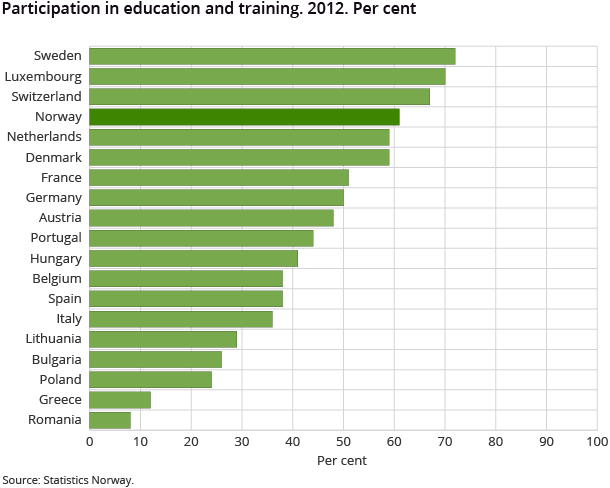Content
Published:
This is an archived release.
Increased participation in adult learning
About 61 per cent of adults in Norway participated in education or training in 2012 compared to 55 per cent in 2007, an increase of 6 percentage points. There is no significant gender difference in participation in 2012.
| 2007 | 2012 | |
|---|---|---|
| All 25-64 years | 55 | 61 |
| Sex | ||
| Males | 53 | 61 |
| Females | 56 | 62 |
| Age group | ||
| 25-34 years | 65 | 72 |
| 39-49 years | 57 | 66 |
| 50-64 years | 45 | 50 |
| Educational attainment level | ||
| Basic school level or no education completed | 38 | 44 |
| Upper secondary education | 52 | 60 |
| College and university level | 72 | 78 |
Figures for Norway from the Adult Education Survey (AES) show a slight decline in participation in formal education and training, from 10 per cent in 2007 to 9 per cent in 2012. The largest decline was recorded among persons with university education with about 4 percentage points. There is however an increase in non-formal education and training participation from 51 per cent in 2007 to 57 per cent in 2012.
Youth and highly educated participate often
Persons in the lower age groups participate more in education and training. In 2012, approximately 72 per cent aged 25-34 years participated in education or training, while only 50 per cent of 50-64 year olds did the same.
Figures from both 2007 and 2012 show that persons with higher education tend to participate often in education and training. About 72 per cent of persons with higher education participated in education and training in 2007, and this figure increased to 78 per cent in 2012. The corresponding figures for persons with primary and lower secondary education were 38 per cent and 44 per cent respectively.
Labour force participation influences adult learning
Figures from the Adult Education Survey (AES) show the importance of work in adult learning. The majority of the training activities are work related and a large part took place during paid working hours. Participation in education and training during paid working hours within the population 25-64 years increased from 39 per cent in 2007 to 46 per cent in 2012. Only persons with higher education registered a reduction in participation and training during paid working hours between 2007 and 2012, with 13 percentage points.
Norway has high levels of adult learning
Norway together with other Nordic countries experience high levels of participation of adults in education and training. The Nordic countries are also characterised by minor differences in gender with respect to participation. Figures from the AES show that Sweden, Luxembourg, Switzerland and Norway have over 60 per cent participation in adult learning. Sweden and Luxembourg have particularly high participation rates.
There are significant country differences across Europe ranging from about 8 per cent in Romania to 50 per cent in France and Germany.
Contact
-
Anna-Lena Keute
E-mail: anna.keute@ssb.no
tel.: (+47) 95 44 30 88
-
Kjartan Steffensen
E-mail: kjartan.steffensen@ssb.no
tel.: (+47) 90 61 05 17

